Progress North Texas 2020
Contents:Message from the ChairConnecting the Dots in the Region Growth and Mobility
|
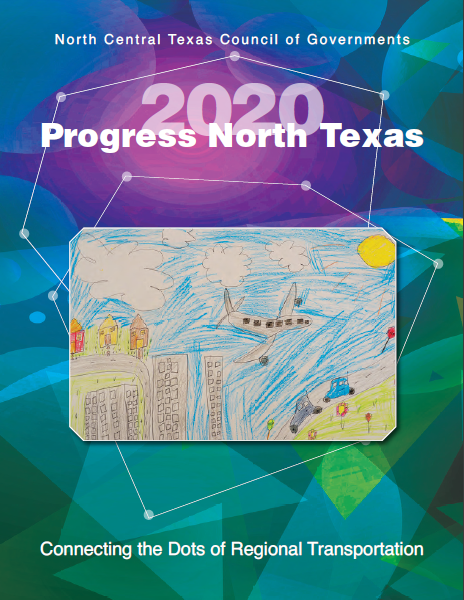 |
Message from the Chair
Dear Neighbors,
Thank you for reading Progress North Texas 2020. This year’s theme is Connecting the Dots of Regional Transportation. In a metropolitan area as fast-paced as Dallas-Fort Worth, it is important to provide residents with many choices of how to move from Point A to Point B.

Roads. Rails. Trails. Each has its role in making the region’s transportation system reliable for its users. And many times, they complement one another to help people get where they need to go. If you Ride the A-train from Denton to Lewisville, for instance, you will likely either drive or ride your bicycle to the station. When you get off the train, you may walk or take a bus to your destination. If you rode your bike and brought it on the train, you could try the new A-train Rail Trail, the 19-mile facility that parallels the commuter rail service.
These are just a few examples of how we use the region’s system. What about when we need to travel outside the Dallas-Fort Worth area? You can add aviation to the mix as a mode that connects us to other regions. Our general and commercial aviation assets are strong and growing to meet our business and leisure demands.
Connecting the dots can have many different meanings. Just ask the students who participated in this year’s art contest. We asked the children of NCTCOG Transportation Department staff to show us how they travel to some of their favorite places and received some terrific answers that show their creativity. Congratulations to Louisa Hathcock whose creation is on this year’s cover.
Whether driving alone, carpooling, taking transit or opting for a more active mode of transportation, North Texans can choose what works best for them because of our continued investment in the transportation system.
I invite you to help us shape our transportation system for the future by becoming part of the planning process. There are many ways you can get involved, from attending or watching public meetings to visiting our staff when we are out at community events. And feel free to reach us on social media with your questions and comments.
Whatever method you choose, we want you to become and remain an integral part of the transportation planning process. But first, I want to thank you personally for your commitment to learn about the transportation planning process by reading Progress North Texas.
Andy Eads
County Judge, Denton County
Chair, Regional Transportation Council
Growth and Mobility
Population and job growth have become the norm in Dallas-Fort Worth over the years. In 2018, according to the US Census Bureau, the metropolitan area added 131,000 people, more people than any other region across the country. The region now has more than 7.5 million people and is expected to eclipse 11 million by 2045. In 2018, employment grew by 3% to 5 million jobs. With these changes and the investments being made in the transportation system, mobility across North Texas remains reliable.
One way to measure mobility is the length of commutes. According to the American Community Survey, 55% of the commuters in the area have a travel time from home to work of 30 minutes or less. The average commute time considering all residents of the 12 counties is 30 minutes. The distribution of commuters by travel time can be seen below.
Approximately 81% drove alone to work and 10% carpooled. The development of the Dallas Fort Worth Tolled Managed Lane System is one way for planners and policymakers to help mobility in an environment where needs outpace available funding. Since 2014, more than 250 miles of TEXpress Lanes have opened on select corridors across the region. These lanes have been built adjacent to the tax-supported general-purpose lanes and allow drivers to pay for a more reliable commute. The tax-supported lanes, which can be used for no additional charge, have also been improved in these corridors.
The region has experienced robust population growth for decades. Since 2010, the12-county area has added 1 million people, with Collin, Denton and Rockwall Counties experiencing the highest percentage growth, adding approximately 30% more residents. The population of the MPA grew 15.5% in the same period. Collin County is now home to more than 1 million people; Tarrant County has grown to over 2 million residents. An examination of roadway congestion in Dallas-Fort Worth and other regions across the country shows congestion remains relatively constant in DFW despite the growth. Other regions’ experiences have been different in recent years.
According to TomTom, North Texas is the 35th-most-congested region in the US. Its overall rate was up slightly in 2019, but the region remains lower than many comparable cities, including Austin, 15th: Atlanta, 22nd; and Houston, 26th. Dallas-Fort Worth motorists spend an average of 19% more time traveling because of congestion. By comparison, congestion costs Houston drivers 24% more time. The graphic on the next page shows that while the region’s population grew substantially last decade, congestion remained relatively constant, even decreasing at times.
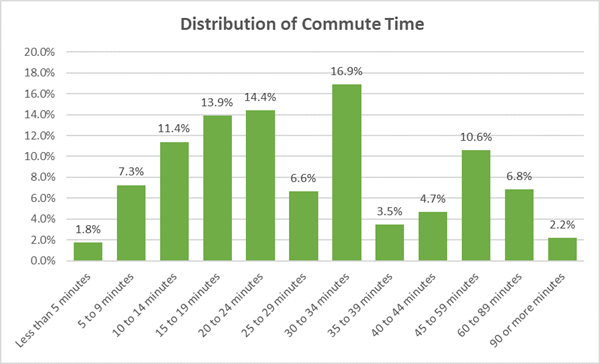
Most commuters can get to work within 30 minutes using the region’s roads. According to the American Community Survey, 55% of commuters could drive from home to the office in 30 minutes or less. This chart shows he distribution of commute times across the region. Source: Census Bureau
This can be attributed in part to the continued investment in transportation. This can be attributed in part to the continued investment in transportation projects. Since 2000, more than $20 billion has been spent on roadway projects.

By another measure, the Inrix Global Scorecard, DFW is 20th nationwide in congestion, with drivers losing 93 hours to traffic in 2019. The number of registered vehicles continues to grow, nearing 6.5 million. With more vehicles on the roads, average daily traffic also continues to climb, as measured at permanent stations across the region. The North Central Texas Council of Governments has set targets to measure peak-hour excessive delay and will continue monitoring this measure. While automobiles continue to be the most popular way to travel in Dallas-Fort Worth, investments are being made in transit and active transportation that will help connect people to one another.
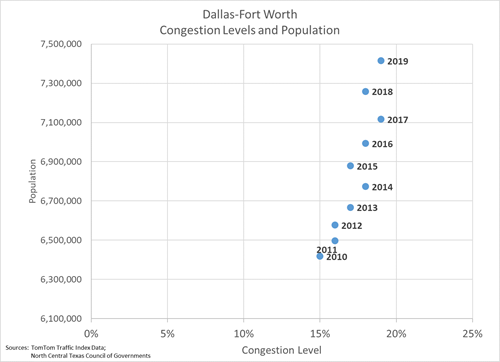
Dallas-Fort Worth has welcomed more than 1 million new residents since 2010. As the population has risen, traffic congestion has remained relatively constant, thanks in part to the investment in significant transportation projects over the past 20 years. Drivers spent 19% more time on the road last year due to traffic congestion, making DFW the 35th-most congested region in the nation. Source: Inrix
Roadways
An efficient roadway system is one of the most important ways to connect the dots for the region’s residents and businesses. Whether adding new capacity or managing the existing infrastructure, NCTCOG and its transportation partners are working to maintain an effective roadway network providing adequate transportation choices to North Texans. The roads can be used exclusively for travel and goods movement from one part of the busy region to the other. Or they can facilitate first- and last-mile connections for residents opting for the region’s growing rail and bicycle-pedestrian networks. All elements of the transportation network work together to ensure a prosperous, vibrant region.
The backbone of a successful transportation system is reliability. Dallas-Fort Worth continued to invest in additional roadway capacity in 2019, adding approximately 300 centerline miles of capacity improvements. Many other projects scheduled or underway will be finished in the coming years. This includes LBJ East, the planned reconstruction of 11 miles of IH 635 improving access to parts of Dallas, Garland and Mesquite. This project will enhance capacity along an important stretch of the Dallas area and lead to the development of more-efficient connections to the rest of the region.
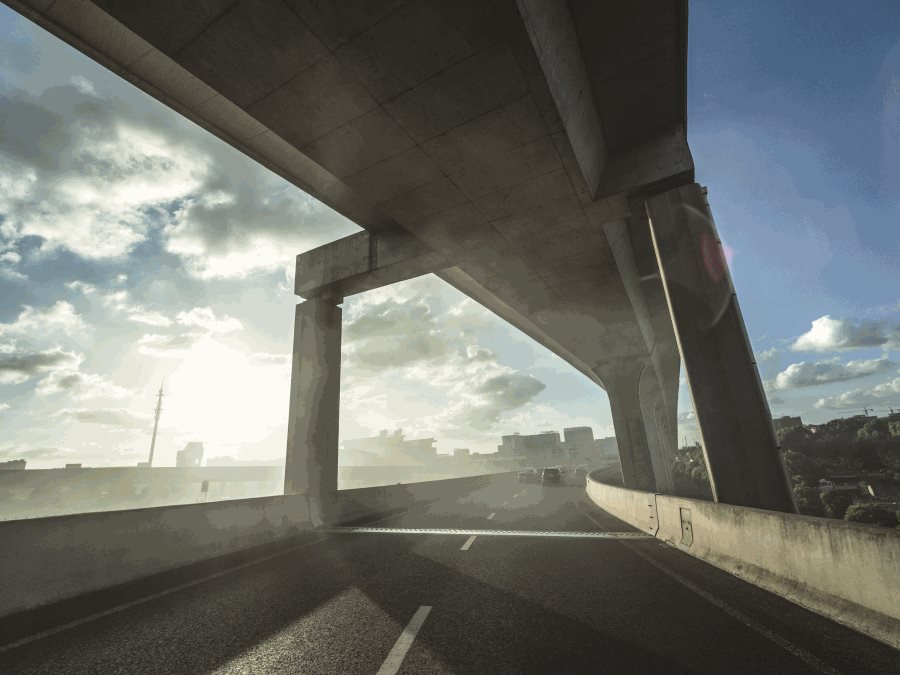
On the west side, the final segment of 35W Express, is also moving forward. The $910 million project to rebuild 6.7 miles of IH 35W from just north of US 81/287 to Eagle Parkway reached financial close over the summer. NCTCOG and its partners project spending $136 billion through 2045 to meet the region’s transportation needs. While capacity improvements are essential, the existing infrastructure must also be maintained to provide people the reliability they expect. Approximately $37 billion has been reserved for infrastructure maintenance over the next 25 years.
Federal Performance Measures
One way to determine the state of the transportation system is the adoption and reporting of federal performance measures. NCTCOG must establish targets or support those set by the Texas Department of Transportation for the condition of pavement and bridges along its 12,000 miles of the national highway system, which includes 3,600 bridges. NCTCOG is supporting the targets set by TxDOT.
NCTCOG has also set targets for the reliability of interstate and non-interstate facilities and will continue monitoring them. NCTCOG will track and, in the future, report the condition of the region's pavement and bridges. The Regional Transportation Council also approved a policy statement to work with local governments to focus on the improvement of NHS local off-system arterials in “poor” condition. For more on the federal measures being collected, visit www.nctcog.org/pm/fed.
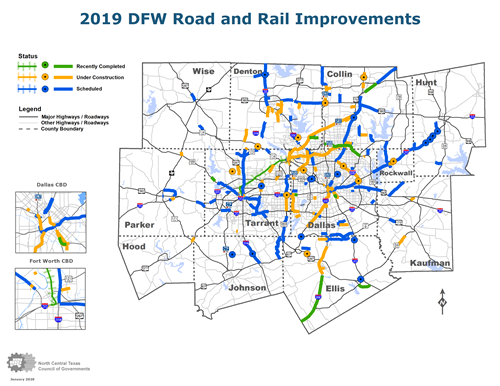
North Texas continued to make significant mobility enhancements in 2019, adding approximately 50 centerline miles of capacity improvements.
INFRA Grant
To address poor bridge conditions in the DFW region, NCTCOG partnered with TxDOT to secure an $8.8 million grant award from the Infrastructure for Rebuilding America, or INFRA, for the North Texas Strategic National Highway System Bridge Program. The program involves seven bridges in five counties in the Dallas-Fort Worth area. This includes bridge replacements and reconstruction, and the removal of one bridge. The seven bridge projects are:
-
Loop 12 northbound over Interstate Highway 35E southbound – Dallas County
-
IH 35W northbound over Interstate Highway 35W southbound Alvarado Exit – Johnson County
-
US 80 eastbound over the East Fork Trinity River – Kaufman County
-
FM 460 over US 80 – Kaufman County
-
US 180 over Dry Creek – Parker County
-
US 287 southbound over Lancaster Avenue – Tarrant County
-
US 287 northbound over Carey Street – Tarrant County
In addition to addressing the condition of these seven bridges, the projects will result in the implementation of dynamic signalizing, signal prioritization and other Intelligent Transportation Systems strategies to reduce congestion. The reduction of congestion will also have a positive impact on air quality by reducing emissions from idling vehicles. With the assistance of continued investments such as the INFRA grants, planners and policymakers will have the resources necessary to improve the condition of the roadway system to meet the federal government’s expectations.
Technology
Improvements to the current transportation system will help keep people connected. How people and goods move around on that system could see significant changes over the next few years. North Texas has pioneered the testing of automated vehicle technology, with Arlington and Frisco hosting separate deployments through 2019. And there is more happening with many potential transportation solutions that could be folded into the system of the future.
AV Freight
The region welcomed automated freight activity in earnest last year, with five AV freight companies beginning work in North Texas. Among them was Kodiak Robotics which announced in summer 2019 that it had started making commercial deliveries along the IH 45 corridor between Dallas and Houston. Kodiak, which began by using a safety driver, also opened a new facility in North Texas to support its expanding operations. While AV trucks navigate the roads of the region, an innovative way to complete last-mile deliveries is also underway. Sidewalk delivery robots are appearing in Frisco, Plano, and now in Richardson with UT-Dallas’ deployment of Starship Robotics delivery bots. UTD has partnered with Starship to introduce 30 robots to deliver food, drinks and snacks from participating vendors across campus. Students use an app on their phones to unlock the robots. Earlier in the year, FedEx introduced a similar device allowing retailers to deliver goods to nearby customers the same day they are ordered. The technology was tested in markets across the US, including Dallas-Fort Worth.

The University of Texas at Dallas has partnered with Starship Robotics to introduce robots to deliver food to students. This concept is also being tested elsewhere in the region to make “last mile” connections. Source: Starship Photo
Innovative Partnerships
AllianceTexas teamed up with public- and private-sector partners to launch the Mobility Innovation Zone, which will help move many transportation innovations and technologies from testing to market viability. Two examples of technologies that could benefit from this partnership are unmanned aircraft systems and automated trucking.

Transportation Data Sharing
During the year, more cities began connecting their traffic management centers to the 511DFW and Waze for Cities platforms. These platforms allow transportation management centers to access crowd-sourced data and other transportation information to improve their roadway operations. Additionally, NCTCOG and a group of regional partners are working to get this same data into 9-1-1 call centers across the region to help improve the situational awareness for first responders.
| City of Allen |
|---|
| City of Arlington |
| City of Burleson |
| City of Cedar Hill |
| City of Denton |
| City of Frisco |
| City of Lewisville |
| City of McKinney |
| City of Plano |
Several cities across the region are sharing data with NCTCOG as part of the transportation data sharing program. This leads to improved mobility throughout the area.
Environmental Justice
Technology can be used to ensure investments are being made equitably. The Environmental Justice Index maps low-income and minority populations in the Dallas- Fort Worth area. Transportation planners can use the EJI to implement federal environmental justice principles in planning, analysis and outreach, such as:
-
Estimating the equity of a project’s impacts by overlaying the project on the EJI
-
Analyzing the equity of project selection and prioritization
-
Informing outreach strategies to engage all members of the community
The Transit Accessibility Improvement Tool (TAIT) provides data on demographic groups who may require public transit to meet their daily needs. These groups include people who are below poverty, age 65 and older or who have disabilities. Analysis and outreach conducted based on the TAIT may identify a need to expand public transit options. Additional data provided in the TAIT helps transit providers comply with federal civil rights requirements. The data for the EJI and the TAIT is provided through the US Census Bureau’s American Community Survey. Users can view both tools online and can download the data.
Environmental Justice Index: www.nctcog.org/trans/involve/ej
Transit Accessibility Improvement Tool:
https://www.nctcog.org/trans/plan/transit/transit-providers/transit-provider-resources
High-Speed Transportation
Work to select a high-speed technology to transport passengers across the region continues. In December, NCTCOG received six proposals from consultant teams interested in studying the Dallas-Fort Worth-Arlington corridor. Hyperloop, high-speed rail and magnetic levitation are among the possible technologies the region could add to its multimodal transportation system. The NCTCOG Executive Board selected a consultant in spring 2020 that will partner with NCTCOG to study high-speed technologies and potential routes for the region. The consultant will also analyze the environmental impacts of potential modes through a federal process aimed at ensuring projects can be completed without disproportionately affecting specific groups. A separate effort to examine high-speed options from Fort Worth to Laredo is underway. Planners in Dallas-Fort Worth, Waco, Killeen-Temple, Austin, San Antonio and Laredo are looking at different technologies, including high-speed rail and hyperloop. Additionally, NCTCOG is pursuing a facility that would serve as a certification center for Virgin Hyperloop One's technology to be used in US markets.
Safety
When connecting the dots across the region, it is essential to keep a sharp eye on safety. In a metropolitan area as large as Dallas-Fort Worth, traffic crashes will occur. What is important is the response. NCTCOG works to improve the safety of the transportation system through the development and implementation of programs and projects that reduce the number of crashes, serious injuries and fatalities on area roadways.
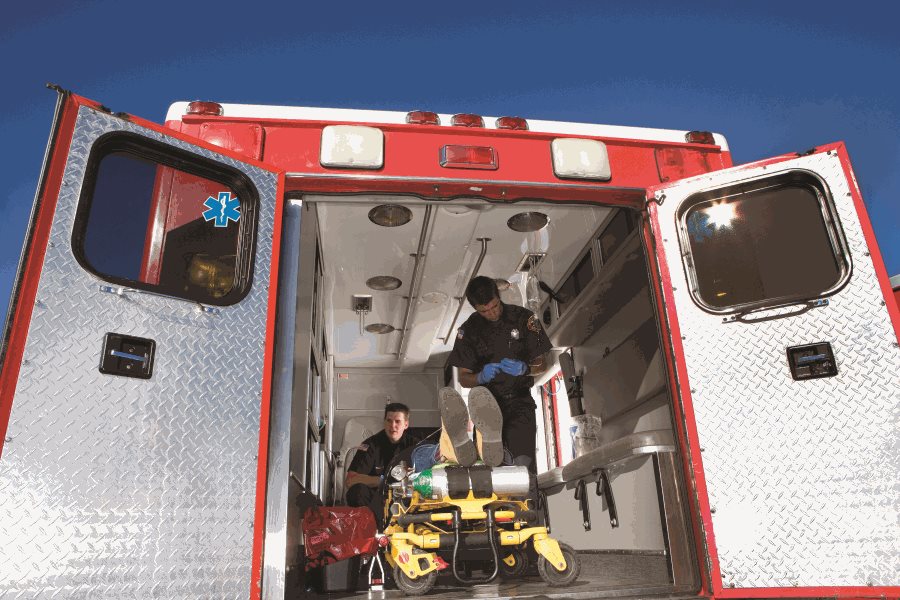
12-County Crash Totals
In 2019, the 12-county Dallas-Fort Worth area experienced 127,823 crashes, including 658 fatal crashes. These numbers reflect the importance of training for agencies and responders who manage and clear traffic incidents, as their lives and the lives of all motorists are in danger the longer they are exposed on the roadways. Policymakers are also taking a close look at safety, with the Regional Transportation Council approving a policy saying, “Even one death on the transportation system is unacceptable.” NCTCOG is working to improve roadway safety through the Traffic Incident Management training to local police, fire, wreckers, EMTs and courtesy patrol agencies. These agencies coordinate to respond to crashes to enhance safety for public and emergency personnel; the result is crashes can be cleared more quickly which also helps reduce upstream traffic collisions. More than 3,200 emergency responders from 127 cities and counties throughout the region have completed the TIM Training offered by NCTCOG.
| County | Total Crashes | Fatal Crashes |
|---|---|---|
| Collin | 13,936 | 47 |
| Dallas | 55,258 | 257 |
| Denton | 12,191 | 47 |
| Ellis | 2,794 | 22 |
| Hood | 798 | 10 |
| Hunt | 1,363 | 23 |
| Johnson | 2,395 | 34 |
| Kaufman | 2,018 | 27 |
| Parker | 2,199 | 26 |
| Rockwall | 1,583 | 2 |
| Tarrant | 32,358 | 149 |
| Wise | 930 | 14 |
| Total | 127,823 | 658 |
Source: TxDOT
Safety Targets
NCTCOG continues to work with TxDOT to reduce fatalities and serious injuries across the region, making the roads safer for drivers and first responders handling incidents. The goal is to improve mobility and safety by attaining a 2% drop in serious injuries and fatalities by 2022.
Planners will be aided in their efforts to reduce crashes by regional safety-related projects such as Mobility Assistance Patrols, the Wrong Way Driving Mitigation Program and the Intersection Safety Implementation Plan, in addition to the ongoing Traffic Incident Management efforts.
Mobility Assistance
Mobility Assistance Patrols also provide help to stalled or stranded motorists along interstate corridors in Dallas and Tarrant counties and portions of Collin and Denton counties, along with toll roads managed by the North Texas Tollway Authority and private operators on LBJ and North Tarrant Express. In 2019, mobility assistance patrols helped over 152,000 motorists get their vehicles moving again or provided protection to motorists and first responders. To help ensure the safety of first responders, remember Texas law to move over or slow down if you see an emergency vehicle on the side of the road.
Wrong-Way Drivers
Wrong-way driving crashes do not occur with great frequency on North Texas highways; however, they tend to be among the most harmful crashes. Over the past five years, there have been an average of 700 wrong-way crashes in the 12-county region, with 100 of these crashes resulting in at least one fatality or serious injury. Due to the severity of these crashes, NCTCOG continues to work with the Dallas and Fort Worth TxDOT districts to execute the Wrong Way Driving Mitigation Program. This leads to the implementation of intersection, highway and technology improvements that assist in preventing wrong-way driving crashes and incidents.
Among the ways wrong-way driving is being addressed on the region’s roads is through strategies to replace conflicting lane and arrow markings, make signal enhancements and other intersection-related improvements in Dallas County and cities across the region. Almost 400 intersections on the eastern side of the region have either been finished or are near completion.
Additionally, seven miles of freeway corridors in Tarrant County were addressed as part of the program. Some of the improvements made to help reduce wrong-way driving were radar, high-definition cameras and additional signage.
NTTA has begun using thermal imaging to detect wrong-way driving on the main lanes of its tolled facilities. Additionally, sensors in the pavement on entrance ramps are used to determine if a vehicle is traveling in the wrong direction. When this happens, automatic alerts are sent to NTTA staff who notify law enforcement. NTTA also continues to add prevention measures like flashing signs to correct a wrong way driver’s travel before they enter the highway.
| TxDOT | NCTCOG | |
| Fatalities | 4,068 | 589 |
| Fatality Rate | 1.48 | 0.803 |
| Serious Injuries | 18,602 | 3,515 |
| Serious Injury Rate | 6.56 | 4.768 |
| Non- Motorized Fatalities and Serious Injuries | 2,477 | 595 |
NCTCOG has embraced a series of federal targets in an effort to reduce fatalities and serious injuries.
Public Involvement
Completing projects that allow people to move more efficiently is important in a region growing as quickly as Dallas-Fort Worth. A continual dialogue with people who live, work, play and go to school in the region about the importance of transportation planning and air quality will help them connect the dots. NCTCOG uses a comprehensive Public Participation Plan to outline strategies for how to communicate with residents about transportation and air quality.

Whether visiting with residents at community events, engaging with them on social media or presenting information at public meetings or offering virtual public input opportunities, NCTCOG planners are committed to helping people understand how the transportation system is working for them.
Interacting with the Public
In 2019, Transportation Department staff appeared at 16 community events attended by approximately 200,000 people. These events, both large and small, allowed staff to interact with the public to promote a better understanding of how different elements of the transportation system work together to improve mobility.
Additionally, there were seven public meetings and four online input opportunities scheduled throughout the year to provide residents the chance to hear about plans and share their thoughts about transportation and air quality. The meetings are also streamed live online, allowing people to watch presentations where they are, without having to drive across town.
Monthly meetings of the Regional Transportation Council, NCTCOG’s transportation policymaking body, are also streamed live on the internet. Last year, there were approximately 500 views per month of Transportation Department meetings online. The department also archives these meetings, allowing people to watch specific portions of sessions, or entire meetings, when it is convenient for them. The busiest month was October, when the RTC discussed high-speed transportation and the potential of a hyperloop certification center in the Dallas-Fort Worth area.
Social Media Growth
Personal interactions with people are valuable in the broadening of their understanding of what NCTCOG does. The department also relies on publications and a social media presence to help spread the word to a broader audience. The department also relies on publications and a social media presence to help spread the word to a broader audience. The department’s social media reach continues to grow, and publications are distributed in print and online. The @NCTCOGtrans Facebook and Twitter accounts saw followers increase by approximately 10% in 2019. The most popular topics were public meetings and outreach (22%) and air quality and sustainability (18%). Posts related to transit (4.2%) and innovative vehicles and technology (3.8%) were the most engaging posts.
| Topic | Posts | Engagement | Reach | Share of Reach |
|---|---|---|---|---|
| Transit | 85 | 4.2% | 69,168 | 10.9% |
| Innovative Vehicles/ Technology | 27 | 3.8% | 33,600 | 5.3% |
| Bike/ Pedestrian | 90 | 3.0% | 87,671 | 13.8% |
| About Us | 8 | 3.0% | 3,567 | 0.6% |
| Aviation | 28 | 2.0% | 39,818 | 6.3% |
These are the five most engaging topics covered on the department’s Facebook and Twitter pages in 2019.
Media Relations
NCTCOG can reach thousands of people through social media. Additionally, it can communicate with more people through media relations. In 2019, the department distributed 26 press releases to the media to highlight many of its projects and programs and how they affected the lives of North Texans.
Additionally, approximately 100 interview requests were received from a variety of media outlets covering transportation and air quality in Dallas-Fort Worth and other regions. The department was mentioned in the media approximately 200 times, with stories about hyper-loop and bicycle-pedestrian facilities drawing significant coverage.
Evolving Approach
The Transportation Department will continue to rely on a mix of these tactics while keeping an eye out for new ways to reach the region as technology advances. Examples of how staff has used technology to reach different audiences are video, virtual engagement and podcasts. The department began a Trail of the Month video series over the summer to highlight many of the region’s significant bicycle- pedestrian facilities. Participation in a variety of podcasts has allowed NCTCOG to reach more specialized audiences.
Back to top
Air Quality
North Texas meets the Environmental Protection Agency’s standard for all pollutants except ozone. The region is trying to meet two standards for ozone concentration, one established in 2008 (75 parts per billion), for which 10 counties are designated “nonattainment,” and one from 2015 (70 ppb), affecting nine counties. The region remains engaged in efforts to reduce emissions levels, protect health and comply with federal air quality requirements as it seeks to meet the 2021 deadline for these standards. The focus on air quality in transportation planning is producing results. Ozone concentration levels have declined from 102 ppb in 1998 to 77 ppb in 2019.
2019 Ozone Season
8-hour Ozone NAAQS Historical Trends
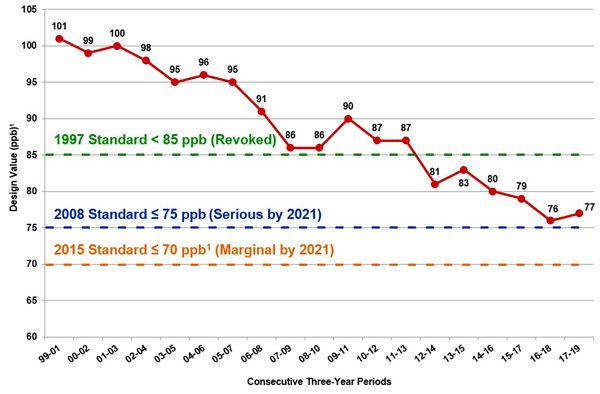
According to the EPA, ozone attainment is reached when, at each monitor, the Design Value (the three-year average of the annual fourth-highest daily maximum eight-hour average ozone concentration) is less than or equal to 75 ppb for the standard established in 2008 and 70 ppb for the standard established in 2015.
An Important Focus
Mobile sources, such as cars and trucks, aircraft, locomotives and construction equipment, account for a significant percentage of the region’s Nitrogen oxide emissions. Therefore, efforts in the region are focused on reducing emissions from these mobile sources. Over half of the on-road NOx emissions are a product of light- and medium-duty vehicles. In 2019, light-duty vehicles alone (cars and small trucks) accounted for over 40% of on-road NOx emissions. NCTCOG monitors NOx and Volatile Organic Compounds closely as part of its commitment to track federal performance measures. With the help of new projects implemented throughout the region, such as bicycle- pedestrian trails, intersection improvements, scrapping older vehicles with high-emitting engines and multi-city efforts to improve traffic signal timing, there has been a decline in NOx and VOC. NCTCOG is working with partners to identify more projects that could allow this progress to continue.
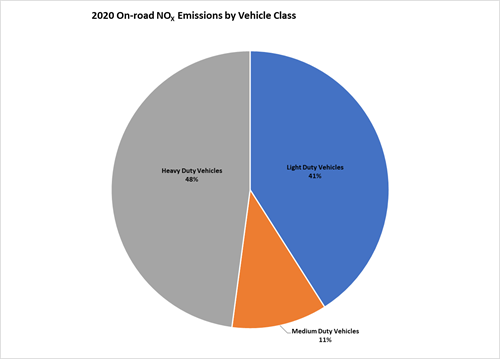
NOX Contributions from mobile sources in North Texas
Electric vehicles and other alternatives to gasoline can help make the region’s air healthier to breathe. Electric vehicles represent a growing sector in transportation and offer benefits to both owners and the region. They are quiet, safe and fun to drive. They also are an important point in a region still working to meet the federal government’s ozone standards. EVs have grown substantially in recent years, 13,000 in January 2020. EVs have grown substantially in recent years, from fewer than 300 in 2011 to 13,000 in January 2020.
Entities across North Texas have worked to build charging stations to allow EVs to get around reliably. There are over 400 such stations in North Texas, according to the latest estimates. The US Department of Energy’s Alternative Fueling Station Locator allows the public to search an interactive map for those locations. For access to the AFDC Station Locator and other EV information, visit www.dfwcleancities.org/evnt.
Alternative Fuel Corridors
To ensure people who adopt these emerging technologies can travel reliably, the Federal Highway Administration has designated a national network of Alternative Fuel Corridors. As of the third round of designations, 100 interstate and 76 US highway corridors have been nominated. Overall, the corridors make up 135,000 miles of the National Highway System in 46 states. Texas contains more than 13,000 miles of the alternative fuel network, roughly 10% of the national total. Dallas-Fort Worth has several highways designated as either “corridor-ready” or “corridor-pending” for all alternative fuels. The diverse fuels help emergency fleets prepare and respond to the region in recovery from natural disasters or fuel shortages. Corridors also help alleviate range anxiety. By providing people with more options, these corridors could lead to greater adoption of alternative fuel vehicles. Ultimately, the use of alternative fuels lowers VOCs and NOx, which results in lower ozone readings at air quality monitoring stations.
Zero-Emission Vehicle Deployment Plan
NCTCOG has received funding for a plan to develop a network of electric vehicle charging and hydrogen refueling infrastructure along Interstate Highway 45. This is a critical step in the transition of this highway into a Zero-Emission Vehicle Corridor and will enable emissions-free travel, with focus on the freight sector.
NCTCOG is working with the Houston-Galveston Area Council and a stakeholder group that includes fleet users, hydrogen and electric vehicle industry representatives, research groups and utilities. This initiative is part of a longer-term, broad view of IH 45 as a strategic corridor for sustainable initiatives, which could include items such as autonomous vehicle technologies, truck platooning and other emerging transportation elements.

Air Quality Initiatives
NCTCOG administers air quality programs and initiatives to support emissions reductions across the region. Programs predominantly focus on light- and heavy duty vehicles and equipment since they represent most ozone forming emissions.
DFW Clean Cities Coalition
The Dallas-Fort Worth Clean Cities Coalition, designated in 1995, works to advance energy security, protect environmental and public health, and stimulate economic development by promoting strategies to reduce transportation energy impacts and improve air quality. Its primary focus is in the transportation sector, collaborating with public and private vehicle fleets to increase the use of alternative fuel vehicles, reduce vehicle idling and implement other fleet efficiency practices. Efforts by DFW Clean Cities stakeholders displace over 23 million gallons of gasoline each year. To get involved and stay informed, visit www.dfwcleancities.org.
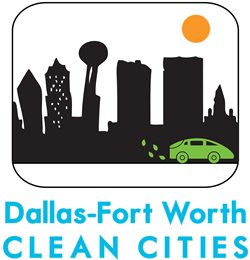
Emissions Reduction Strategies
Engine Off North Texas (EONT) encourages the public, truck drivers and local governments to reduce their idling. EONT connects the public with resources from local governments to better serve the people. EONT also manages a heavy-duty vehicle idling complaint hotline that allows North Texans to report to NCTCOG. Since the beginning of 2019, letters have been mailed out to idling vehicle owners. Spread awareness of EONT by learning more at www.engineoffnorthtexas.org.

With grants from funding programs, such as the Clean Fleets North Texas program, fleets are assisted in replacing older, heavy duty diesel vehicles with newer, less-polluting vehicles. By replacing these vehicles, fewer emissions are emitted while they fulfill their vital roles in service to communities. Since applications began to be accepted for Clean Fleets North Texas in March 2018, vehicles and equipment awarded include: school buses, fire trucks, refuse haulers, dump trucks and construction equipment.
Car Care Clinics
Car Care Clinics bring vehicle maintenance awareness to drivers in North Texas. Owners take their vehicle to partnering repair facilities where they have an opportunity to talk to a certified technician at no charge. The facility also performs a free multipoint inspection. More information can be found at www.ntxcarcare.org.
Regional Smoking Vehicle Program
Since 2007, the Regional Smoking Vehicle Program has allowed North Texans to help improve air quality by anonymously reporting vehicles emitting visible tailpipe smoke. Reporting can be completed online or by phone. To date, more than 31,000 vehicle owners have been notified of their smoking vehicles. More information can be found at www.smokingvehicle.net.
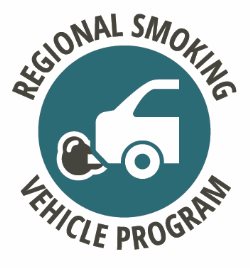
Sustainable Development
Active transportation in the Dallas-Fort Worth area is supported by an extensive system of shared use paths called the Regional Veloweb. This network of trails boasts nearly 1,000 miles of existing or funded facilities, with an additional 3,800 miles of planned trails identified in Mobility 2045 for future development. These trails help expand the economies of local communities and offer North Texans sustainable transportation options for connecting to schools, jobs, retail centers and other significant destinations.
NCTCOG is working with stakeholders to implement projects that will unite several existing regional trail corridors that provide significant connectivity between cities and counties throughout North Texas. These corridors provide travel options to numerous downtowns and employment centers including Dallas, Denton, Fort Worth, McKinney, and many historic downtowns and destinations in between. These regional trail corridors also provide direct connections to many light- rail and commuter-rail stations operated by DART, DCTA and Trinity Metro, thus giving transit riders with walking and bicycle access to nearby destinations.
Several sections of these Regional Veloweb trails are in various stages of alignment studies, preliminary engineering, construction design and/or construction. These efforts are being led by and implemented through partnerships involving many local governments including cities, counties, transportation agencies, NCTCOG and TxDOT. More information about these highlighted regional trail corridors is available at www.nctcog.org/Veloweb.
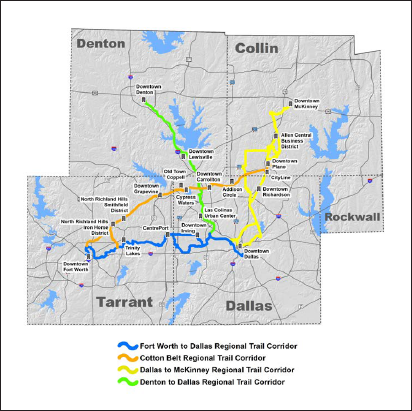
DCTA completed the 19-mile A-Train Rail Trail in 2019. Work continues on several other bicycle-pedestrian trails that will link multiple cities across the region, offering North Texans sustainable transportation options for connecting to schools, jobs, retail centers and other significant destinations
Walk to School Day
It is also important to provide connections to the region’s schools. NCTCOG promoted national Walk to School Day in 2019 by giving away banners, flyers, stickers and prizes to participating campuses. Held annually on the first Wednesday in October, Walk to School Day brings together students, their parents, schools and public officials to celebrate walking, promote healthy behaviors and galvanize support for safety improvements. In 2019, 98 schools in the Dallas-Fort Worth region participated. Frisco ISD led with involvement from 23 campuses. Almost 25 area school districts took part last year. NCTCOG plans to expand promotion in the future and encourage more schools to participate. For more on regional coordination please visit www.nctcog.org/schools.

Parking Management
Parking requirements and management practices have a significant impact on North Texas’ development and transportation system. NCTCOG supports local plans and policies that create efficient and customer service- oriented parking while consuming less land and meeting flexible demand. To advance better policy, a study of parking use was conducted at 16 private developments around DART rail stations. Recommendations and best practices for more sustainable parking have been published at www.parkingtoolboxntx.org.
NCTCOG has also supported consultant-led parking studies in downtown areas not served by transit. For example, Decatur and Wylie both identified potential parking shortages and supply needs around their historic walkable downtowns. Recommendations for these areas include increasing wayfinding to inform drivers of nearby on-street parking and partnering with large private landowners, such as churches, to share their spaces during off-peak times.
In downtown Arlington, a shared parking model was applied to demonstrate the financial benefit of implementing increased mobility options. The study also provided recommendations for policies to reduce reserved parking in favor of more shared and public parking. These and other examples of similar local parking studies can be found at www.nctcog.org/parking.
Gentrification Study
NCTCOG continues to the connect the dots of improving transportation with equitable neighborhood revitalization. Rapid regional growth and renewed interest in urban neighborhoods have led many to question what can be done to mitigate the negative effects of gentrification, the process of higher-income households displacing lower-income residents of a neighborhood. The definition, causes (including the role of infrastructure), and indicators of gentrification are explored in a report by NCTCOG. The report includes 20 public policy tools that local and State governments could implement to assist with revitalizing disadvantaged communities. The full report is available at www.nctcog.org/housing.
Transit
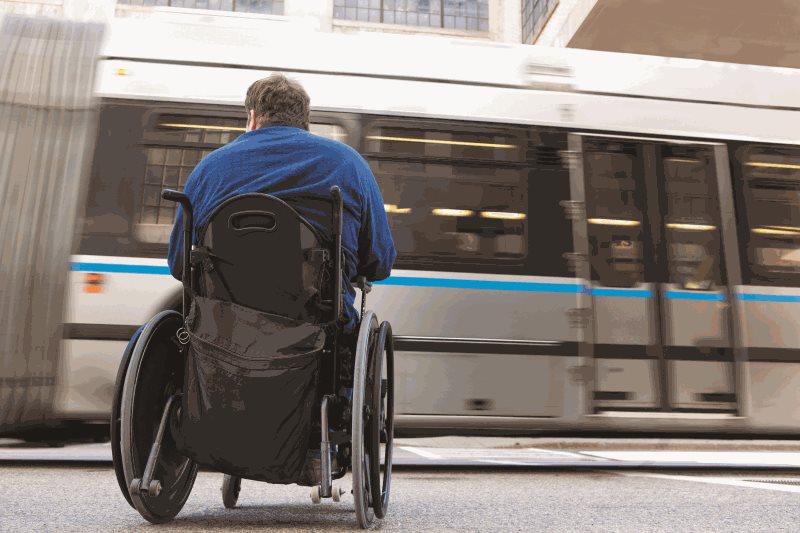
Transit options continued to expand with the January 2019 opening of Trinity Metroʼs TEXRail line from Fort Worth to DFW Airport. TEXRail extended passenger rail to more western suburbs and will provide new opportunities for transit- oriented neighborhoods. Dallas Area Rapid Transit is also developing the Cotton Belt Silver Line and a second downtown line.
Trinity Metro, DART and Denton County Transportation Authority are the major providers of public transportation in the region. The three provided approximately 74.4 million passenger trips in Fiscal Year 2019, an increase of more than 3 million trips over the previous year.
In a metropolitan area as large as Dallas-Fort Worth, all transit partners play a role in connecting people to their destinations. Smaller transit agencies serving the region combined for more than 450,000 trips in Fiscal Year 2019.
My Ride North Texas 2.0
Mobility management emphasizes the coordination of transportation services and non-traditional partnerships to meet the transportation needs of customers. Among the beneficiaries are older adults, people with disabilities, and individuals with lower incomes. NCTCOG uses mobility management as a framework to identify transportation gaps in service, coordinate regional resources and promote effective partnerships to assess and address the needs of the region.
In 2019, NCTCOG was awarded a $511,000 grant from the Federal Transit Administration to implement a regional mobility management program that will improve the coordination of transportation and medical services for populations that currently lack transportation to wellness resources. This grant will be used to fund My Ride North Texas 2.0, which will bridge the gap between the transportation and healthcare providers, thereby improving opportunities for those with limited transportation options.
NCTCOG is working with local partners to establish a region-wide call center to provide timely, accurate transportation information that spans public transit options. The project will leverage partnerships in an effort to build bridges between transit providers, healthcare providers, and community service agencies to position providers and local stakeholders to take the next step to provide needed transportation.
| Transportation Provider | Passenger Trips in FY 2019 |
|---|---|
| City/County Transportation | 37,263 |
| Community Transportation Services | 61,292 |
| Public Transportation Services | 69,958 |
| Span,Inc. | 56,335 |
| STAR Transit | 227,542 |
| Total | 453,390 |
Although the major transit providers are the region’s most visible, smaller providers also play a big role in connecting neighborhoods.
Vanpool Performance
The Regional Vanpool Program helps reduce traffic congestion, improve air quality and lessen commute stress. In 2019 (calendar year), the program, which is operated by DART, Trinity Metro and DCTA, combined to save nearly 34.5 million miles. There are almost 290 active vanpools. NCTCOG is monitoring the percentage of high-occupancy vehicles and has set targets for future performance.
New Services
Several new transportation services and initiatives debuted in 2019, including:
1. A coalition of public transit providers, employers, developers and local governments formed the Southern Dallas County Inland Port Transportation Management Association. Their goal is to connect workers in the inland port area to transportation solutions such as DART’s Golink, STAR Transit’s routes and car sharing programs.
2. Through coordination with community members and local partners, Trinity Metro introduced The Dash, its first electric bus route in Fort Worth. The Dash provides passengers with easy access to downtown Fort Worth, the Seventh Street corridor and the Cultural District.
3. DCTA introduced a shuttle route between Monsignor King Outreach Center to Our Daily Bread to connect Denton’s emergency homeless shelter to local resources and rail services.
4. Collin County Transit now offers an on-demand taxi program for senior citizens, individuals with disabilities and low-income residents who live in Prosper. This partnership between the McKinney Urban Transit District and DCTA provides around-the-clock access to transportation.
Transit Asset Management
NCTCOG is required to set annual performance targets for the region’s transit assets, coordinating with transit providers to ensure consistency. Transit Asset Management is designed to prioritize funding based on the condition of transit assets in a state of good repair, asset reliability, safety and performance. Performance is measured across four asset categories: Rolling Stock, Infrastructure, Equipment and Facilities. The goal is for all assets to be in a state of good repair.
Overall, regional targets are being met for many of the asset categories specifically as it relates to types of assets within each category, based on Fiscal Year 2018 data. However, some assets do fall short, such as: buses, commuter rail passenger coach, transit-support vehicles, and rail infrastructure. Efforts are underway to improve. For more information about Transit Asset Management, please visit www.nctcog.org/pm/fed.
| Regional Vanpool Program | DART | Trinity Metro | DCTA | Combined |
| Total Number of Vans (at end of year) | 174 | 73 | 42 | 289 |
| Average Participants at End of Month | 1,324 | 491 | 312 | 2,127 |
| Total Van Trips Traveled | 2,824,625 | 1,667,529 | 772,221 | 5,264,375 |
| Total Vehicle Miles of Travel Reduced (annual) | 19,211,438 | 10,238,270 | 5,048,814 | 34,498,522 |
| Total Vehicle Trips Removed (annual) | 585,122 | 211,148 | 141,464 | 937.734 |
| NOx Emissions Reduced (pounds) | 11,425 | 6,089 | 3.003 | 20,517 |
| VOC Emissions Reduced (pounds) | 3,808 | 2,030 | 1,001 | 6,839 |
The Dallas-Fort Worth area’s 290 active vanpool combined to save almost 34.5 million miles in 2019. The program remains an important component of the region’s strategy to improve mobility and air quality.
Back to top
Freight
Dallas-Fort Worth is the largest metropolitan area without direct access to a traditional port, making the surface transportation system essential for the movement of freight. Several initiatives are underway that could help companies move goods to market more efficiently. One way to make sure freight can be delivered where it is needed is to address areas where bottlenecks exist.
Freight Land Use Analysis
Goods movement is the lifeblood of the economy, and due to the region’s unique geographic position as a nationwide logistical hub, the facilities that house and support the trucking fleets, railroads, pipelines and freight aircraft are critical regional and national assets. As such, distribution centers and warehouses are a common sight in the Dallas-Fort Worth area.
An important question must be asked: “What is the impact of these facilities on the surrounding communities?” The Freight Land Use Compatibility Analysis seeks to answer this.
The study is underway and assesses the current state of freight-intensive real estate in the region. Some areas being examined include freight sprawl, the presence of land-use conflicts and/or mitigation strategies, amenities, accessibility, commercial vehicle routing, as well as facility age and condition. The goal of the study is to improve the quality of freight land uses throughout the region by providing tools and strategies for cities, counties and decision makers to use when planning for freight infrastructure.
Truck Lane Restrictions
Throughout the past year, NCTCOG planners coordinated with TxDOT on the placement and designation of truck lane restrictions. These restrictions represented an expansion of rules that have been in place along some corridors for more than 10 years. They prohibit trucks with three or more axles from using the inside lane on highly traveled corridors in the region.
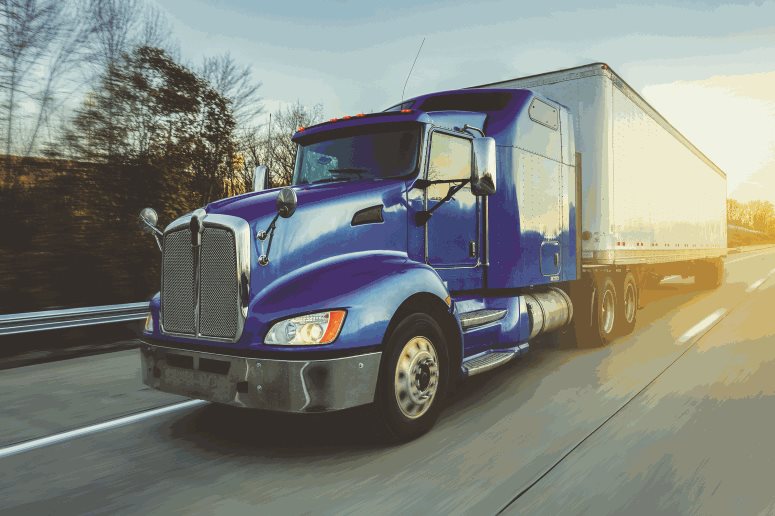
Research from the Texas A&M Transportation Institute indicates that separating truck traffic can improve roadway safety by reducing the severity of truck- involved crashes. The implementation of these additional truck lane restrictions will help ease congestion for passenger vehicles and improve safety in the proposed corridors. The expanded restrictions were approved by the Texas Transportation Commission in October and are being implemented.
Truck Lane Restrictions
US 75 – SH 121 South to Collin/ Grayson County line
IH 45 – Navarro/Ellis County line to Navarro/Freestone County line
IH 35E – US 77N to Ellis/Hill County line
IH 35E – Spur 366 to Corinth Parkway
SH 183 – IH 35E to Dallas/Tarrant County line
US 67 – IH 35E to FM 1382
IH 635 – US 75 to Dallas/Tarrant County line
IH 30 – SH 205 to Rockwall/Hunt County line
Crossing Analysis
Railroad operators move extraordinarily heavy cargo in large quantities through and throughout the region. Railroad tracks and their high tolerance for weight are the infrastructure that allows this. The railroad facilities in the region that make it an attractive location for industrial development also interact with the surrounding roadways in the form of railroad crossings.
While many of the highest traffic rail lines and roadways are grade separated (by a bridge or tunnel), most railroad crossings occur at-grade, or at the same level of elevation. At these crossings, motorists must drive over railroad tracks, and if a crossing is poorly designed or in need of repair, safety and traffic flow issues could result. Therefore, an evaluation is currently underway that attempts to determine the condition of at-grade railroad crossings in the region.
Aspects of crossings to be examined include motorist visibility, the presence of safety measures, deck plate condition, roadway condition, alignment and the surrounding roadway features such as geometry and the presence of signals or signs. Ultimately, the information from this study will be used to inform the prioritization of grade-separation projects and the removal or reconstruction of existing at-grade crossings.
Crossing Incidents
Crashes at rail crossings have fallen dramatically since 2000, when there were 67. In 2019, there were 30, fewer than any other year during this period. Although influenced primarily by traffic levels (both train and car), the location and severity of incidents is helpful in determining which crossings present the highest safety risk to motorists, and therefore require additional safety measures or other types of remediation.
An example of how North Texas’ at-grade crossings have been upgraded is the realignment of intersections to improve sight lines from both directions. NCTCOG will continue working with its partners to enhance the safety and efficiency of the entire freight network.
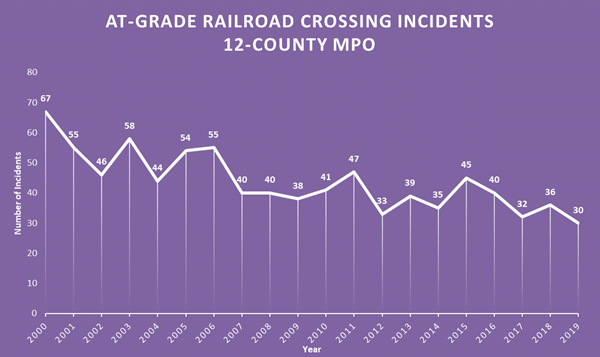
At-grade rail crossing incidents fell in 2019 to their lowest level, according to data collected by NCTCOG
Reliability
NCTCOG tracks truck travel time reliability, a federal performance measure that will help planners understand the efficiency of the transportation system. The baseline is 1.74, meaning a trip that should take 10 minutes will likely take 17.4 minutes. The goal is to reduce this to 17.1 minutes by 2020 and 16.6 minutes by 2022.
Aviation
Aviation is another way to connect to regions throughout Texas and the nation. The industry consists of many different components, some of which are more visible than others. A few examples are commercial aviation, air cargo and general aviation. All are valuable to the continued development of the economy in North Texas.
Air Cargo
When valuable, lightweight cargo needs to be moved quickly, businesses often turn to aviation. Dallas Fort Worth International Airport and Alliance Airport lead the region in transportation of cargo. DFW Airport saw a 7.3% increase in Cargo transported, while Alliance Airport showed a slight decline. However, the airport will likely experience significant future growth with the opening of Amazon’s new regional hub, which began operating at the airport in fall 2019.
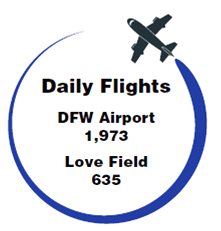
Daily traffic at DFW Airport and Love Field continued to increase in 2019. Despite this growth, the region still has adequate airspace capacity. Together, the airports have the ability to operate more than 5,100 daily flights. Sources: DFW Airport, Dallas Love Field.
Although a significant part of the economy, air cargo attracts less attention at the region’s major airports than air travel. DFW Airport continues to lead the way in commercial aviation, as it transported more than 75 million passengers in 2019, an 8.6% increase over 2018. Flights at DFW soared by nearly 8% in 2019, to almost 2,000. At Love Field, operations increased slightly to 635 a day, while 3% more passengers flew in and out of the airport.
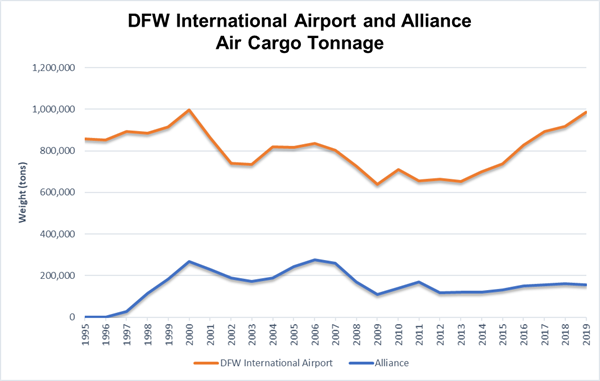
Air cargo shipped through DFW Airport increased by 7.3% in 2019. Alliance Airport remains the region’s No. 2 air cargo facility. Source: DFW Airport, Alliance Airport
Another component of the aviation industry is general aviation. While general aviation typically takes place at smaller airports, it occupies a significant place economically. General aviation remains an important part of the North Texas economy. Regional airport funding increased from $24 million to $31 million, with McKinney National Airport receiving the largest share, $17 million, which included $15 million from a TxDOT grant to extend the runway 1,500 feet. The project is anticipated to help the airport continue to serve as a general aviation reliever for DFW Airport and Love Field.

Unmanned Aircraft Systems
Unmanned aircraft systems, commonly called drones, represent another growing sector of the aviation industry, increasing by approximately 42% in 2019. Currently there are nearly 27,000 drones registered in North Texas. Almost 20,000 are used by hobbyists and 7,000 by non- hobbyists. NCTCOG is working with regional partners to ensure this growing technology can be effectively integrated by users and solutions to problems can be developed. A series of workshops are being held throughout the region to provide information to drone operators on safe flying and rules and regulations they must follow. For more information, visit www.northtexasuas.com.
One of the issues being confronted by drone operators is where to safely fly their aircraft. NCTCOG is working with regional partners to identify the best places to do so. The list includes a number of parks and lakes and will continue to expand, with the assistance of partners.
Back to top
Editor's Note
The remainder of 2020 will be complicated by COVID-19 and our response to the virus, both collectively and individually. The pandemic took us all by surprise and made it difficult to focus entirely on the successes of the past year when putting this report together. Dallas-Fort Worth has enjoyed a long stretch of economic growth going back to the financial crisis over 10 years ago. In the ensuing years, with the assistance of our dedicated transportation partners, NCTCOG and the RTC have worked to meet the demands placed on the system by the influx of more than 1 million new residents.

Although we have not been through a challenge quite like this, we know things will get better. We face a new reality because of this virus, but the same focus that led to the successes of the past can help us emerge stronger.
The RTC is focused on how we use information and data to influence policy. Additionally, infrastructure investments can be used to return us to the success of the past, just as they were during the financial crisis of 2008-2009. Decisions may have to be more strategic for a while, but a problem-solving spirit has driven North Texas’ transportation partners to work together to develop an infrastructure system that provides residents choices for how to move from Point A to Point B. This same focus on results and innovation could make our region a trailblazer in the post-COVID world.
-Brian Wilson
Communications Supervisor NCTCOG
2020 Art Contest Participants
Congratulations to Louisa Hathcock, the winner of this year’s competition. We asked children of our staff to illustrate what this year’s theme of Connecting the Dots of Regional Transportation, means to them. Louisa’s artwork is on the cover of Progress North Texas 2020.
|
Winner: Louisa Hathcock
Age: 9 |
||
 2nd Place : Andrew Wilson Age: 9
|
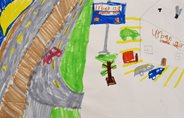 3rd Place: Ethan Brown Age: 12
|
|
All graphics are from NCTCOG, and all photos are from Getty Images, unless otherwise indicated.
Back to top

